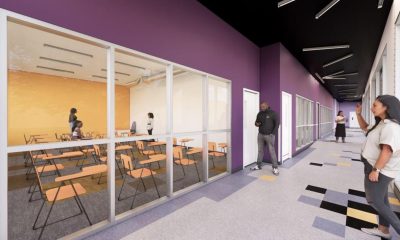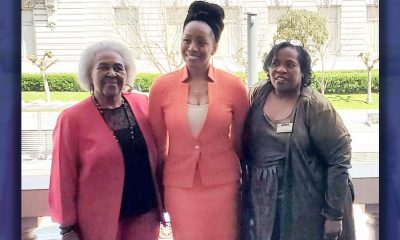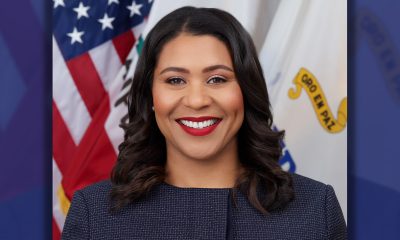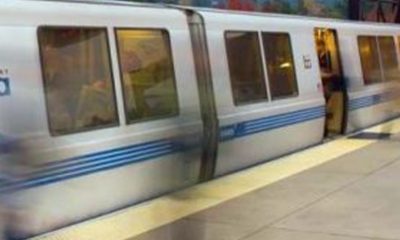Black History
The Way West: Reparations Task Force Looks at Black Migration to California
During its third meeting, California’s Task Force to Study and Develop Reparation Proposals for African Americans looked at reasons formerly enslaved Black people migrated to the Golden State — and detailed setbacks they faced after arriving.
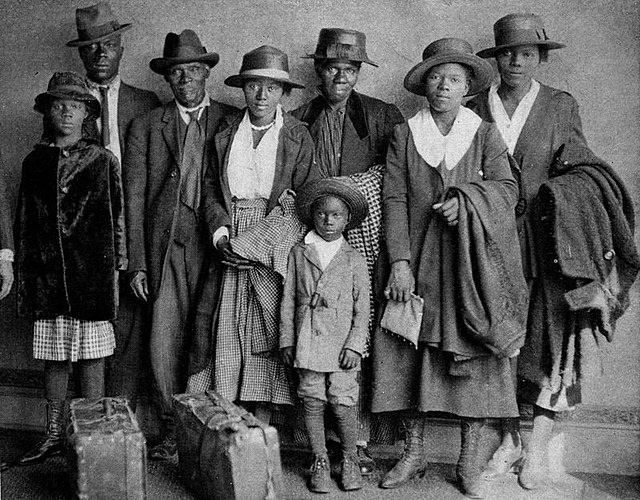
I was leaving the South
to fling myself into the unknown…
I was taking a part of the South
to transplant in alien soil,
to see if it could grow differently,
if it could drink of new and cool rains,
bend in strange winds,
respond to the warmth of other suns
and, perhaps, to bloom.
- Richard Wright, the author of Black Boy, 1945
During its third meeting, California’s Task Force to Study and Develop Reparation Proposals for African Americans looked at reasons formerly enslaved Black people migrated to the Golden State — and detailed setbacks they faced after arriving.
During the period historians dub the “Great Migration”– which lasted from the early 1900s through the 1970s – approximately 6 million Black Americans relocated from Deep South states to Northern, Midwestern, Eastern and Western states. Significant numbers ended up in California, escaping Jim Crow laws and racial violence and seeking economic opportunity.
Isabel Wilkerson, author of “The Warmth of Other Suns: The Epic Story of America’s Great Migration, “described the movement as “a redistribution of Black people.”
“It was the only time in America’s history that American citizens had to flee the land of their birth just to be recognized as the citizens that they had always been,” Wilkerson said, pointing out that no other group of Americans has been displaced under similar conditions.
After President Lincoln signed the Emancipation Proclamation, the Reconstruction era began. It was a period of prosperity as some Blacks in different places began to establish businesses and communities; contest for (and win) political office; establish schools, and more.
But it was short-lived because of white backlash, Wilkerson said.
By the early 1900s, racist white Southerners began to terrorize freed Black people with cross burnings, and racial violence — and discriminate against them by instituting Jim Crow laws.
There was a spike in lynchings, and a sharecropping system that mirrored the conditions of slavery began to take form in the 11 former slaveholding states.
Under those policies, opportunities for Blacks were almost nonexistent.
After World War World I began in Europe in 1914, there was a shortage of labor. Factories started luring Black people North to fill vacancies. By 1919, an estimated 1 million Southern Blacks had departed for the North.
By the 1930s, the Great Depression had slowed Black migration. But the revival of the exodus from the South, a period historians call the “Second Great Migration,” started around 1939.
This time around, California was a major destination.
As Black people left the South, Wilkerson said, they “followed three, beautifully predictable streams — pathways to freedom.” The first two led to Eastern and Midwestern states. The “West Coast stream,” Wilkerson told the task force, “carried people from Louisiana and Texas out to California and the entire West Coast.”
World War II created an expansion of the country’s defense industry, according to the Southern California public television network,. During this time, more jobs were available to African Americans. California cities such as Los Angeles, San Francisco and Oakland began to see an influx of Black people.
According to KCET, a Southern California public television network, the Black population in Los Angeles grew from 63,700 in the 1940s to 763,000 in 1970. The migration was largely fueled by job openings in industries manufacturing automobiles, rubber, and steel. The presence of Blacks became evident along Central Avenue between 8th and 20th streets in California’s largest city.
“(Black southerners) were recruited to the North and West to fill labor shortages in the steel mills, factories and shipyards,” Wilkerson said. “It turned out that they wanted the labor but did not want the people.”
The response to the Great Migration was “structural barriers of exclusion,” Wilkerson said. Restrictive covenants required white property owners to agree not to sell to Black people and many areas in large and mid-range cities were redlined to deny services to Blacks.
“By law and by policies, parents, grandparents or great-grandparents of almost every African American alive today (were denied) the greatest source of wealth in this country: homeownership, the American Dream itself,” Wilkerson said.
“With all the testimony I’ve heard, I don’t see how any person of conscience, character and civility could not understand that the facts have been given,” said Task Force vice-chair, the Rev. Amos Brown, pastor of Third Baptist Church in San Francisco and president of that city’s NAACP branch.
The purpose of the nine-member task force is to study and develop reparation proposals for African Americans and recommend appropriate ways to educate the Californians about the task force’s findings.
Sanctioned from 1619 to 1865, legalized slavery in the United States deprived more than 4 million Africans and their descendants of citizenship rights and economic opportunity. After it was abolished, government institutions at the federal, state, and local levels perpetuated, condoned, and often profited from practices that disadvantaged African Americans and excluded them from participation in society.
“On those sugar, rice, and tobacco fields (in the deep south) were opera singers, jazz musicians, novelists, surgeons, attorneys, professors, accountants, and legislators,” Wilkerson said. “How do we know that? Because that is what they and their children, grandchildren and now great-grandchildren have often chosen to become.”
Wilkerson first gained national attention in 1994, when she became the first Black woman to win the Pulitzer Prize for Feature Writing in 1994, while employed as Chicago Bureau Chief of The New York Times.
Wilkerson’s parents are both from Southern states, but they stayed in Wash., D.C., where she was born, after meeting at Howard University. It was her parents’ migration northward, she says, that inspired her research on an era that helped to shape the country’s current demographics.
“Slavery has lasted so long that it will not be until next year, 2022, that the United States would have been a free and independent nation for as long as slavery lasted on this soil,” she said.
Activism
Oakland Post: Week of April 24 – 30, 2024
The printed Weekly Edition of the Oakland Post: Week of April 24 – 30, 2024

To enlarge your view of this issue, use the slider, magnifying glass icon or full page icon in the lower right corner of the browser window. ![]()
Activism
Oakland Post: Week of April 17 – 23, 2024
The printed Weekly Edition of the Oakland Post: Week of April 17 – 23, 2024

To enlarge your view of this issue, use the slider, magnifying glass icon or full page icon in the lower right corner of the browser window. ![]()
Black History
Matthew Henson: Explorer Extraordinaire
Matthew Henson, a trailblazing explorer who overcame countless obstacles to leave an incredible mark on history. Born on August 8, 1866, in Charles County, Maryland, his journey is a testament to the power of determination and the spirit of adventure.

By Tamara Shiloh
Matthew Henson, a trailblazing explorer who overcame countless obstacles to leave an incredible mark on history. Born on August 8, 1866, in Charles County, Maryland, his journey is a testament to the power of determination and the spirit of adventure.
Henson’s life began amidst the backdrop of post-Civil War America, where opportunities for African Americans were scarce. From a young age, he possessed an insatiable curiosity about the world beyond his small town. At the age of 12, he embarked on a journey that would change the course of his life forever when he joined a merchant ship as a cabin boy.
His most famous expedition was his journey to the Arctic with renowned explorer Robert E. Peary. In 1887, Henson joined Peary’s crew as a seaman and quickly proved himself to be invaluable with his skills as a navigator and craftsman. Over the course of several expeditions, Matthew endured extreme cold, treacherous terrain, and grueling conditions as he and Peary sought to reach the elusive North Pole.
In 1908–09, Peary set out on his eighth attempt to reach the North Pole. It was a big expedition, with Peary planning to leave supplies along the way. When he and Henson boarded their ship, the Roosevelt, leaving Greenland on August 18, 1909, they were joined by a large group. This included 22 Inuit men, 17 Inuit women, 10 children, 246 dogs, 70 tons of whale meat, blubber from 50 walruses, hunting gear, and tons of coal.
In February, Henson and Peary left their anchored ship at Ellesmere Island’s Cape Sheridan, along with the Inuit men and 130 dogs. They worked together to set up a trail and supplies along the way to the Pole.
Peary picked Henson and four Inuit people to join him in the final push to the Pole. However, before they reached their destination, Peary couldn’t walk anymore and had to ride in a dog sled. He sent Henson ahead to scout the way. In a later interview with a newspaper, Henson recalled being in the lead and realizing they had gone too far. The group turned back, and Henson noticed his footprints helped guide them to their destination. At that location, Henson planted the American flag.
Henson’s legacy extends far beyond his expeditions to the Arctic. He shattered racial barriers in the world of exploration and inspired countless individuals, regardless of race, to dream big and pursue their passions. In 1937, he was finally recognized for his achievements when he was inducted into The Explorers Club, an organization dedicated to promoting scientific exploration and field research.
Matthew Henson died in the Bronx, New York, on March 9, 1955, at the age of 88.
-

 Activism4 weeks ago
Activism4 weeks agoOakland Post: Week of March 27 – April 2, 2024
-

 #NNPA BlackPress4 weeks ago
#NNPA BlackPress4 weeks agoBeloved Actor and Activist Louis Cameron Gossett Jr. Dies at 87
-

 Community1 week ago
Community1 week agoFinancial Assistance Bill for Descendants of Enslaved Persons to Help Them Purchase, Own, or Maintain a Home
-

 Activism3 weeks ago
Activism3 weeks agoOakland Post: Week of April 3 – 6, 2024
-

 Business2 weeks ago
Business2 weeks agoV.P. Kamala Harris: Americans With Criminal Records Will Soon Be Eligible for SBA Loans
-

 Activism2 weeks ago
Activism2 weeks agoOakland Post: Week of April 10 – 16, 2024
-

 Community2 weeks ago
Community2 weeks agoAG Bonta Says Oakland School Leaders Should Comply with State Laws to Avoid ‘Disparate Harm’ When Closing or Merging Schools
-

 Community6 days ago
Community6 days agoOakland WNBA Player to be Inducted Into Hall of Fame

